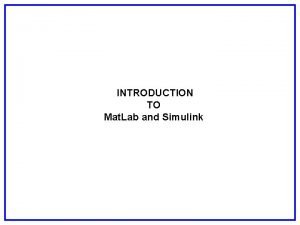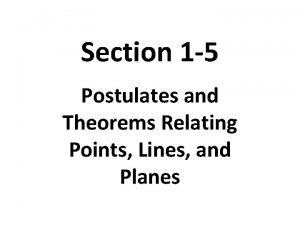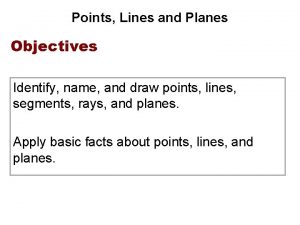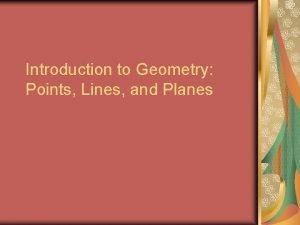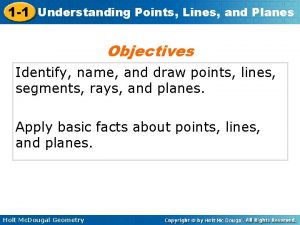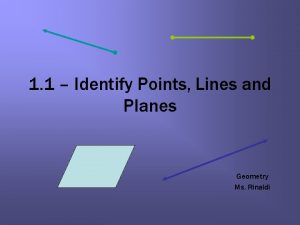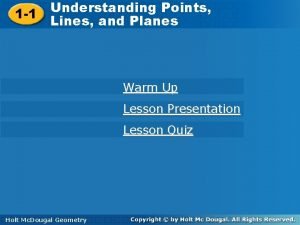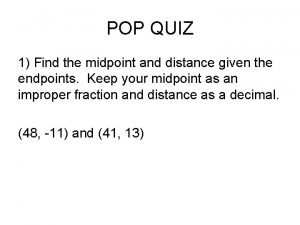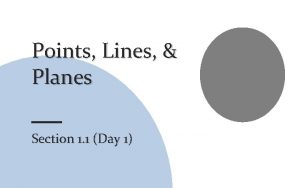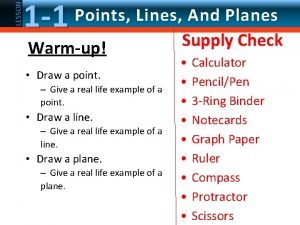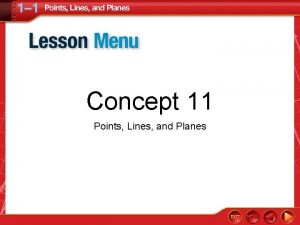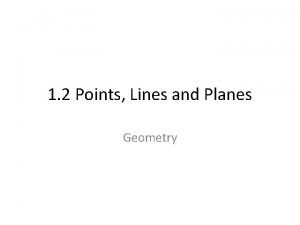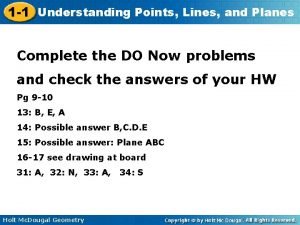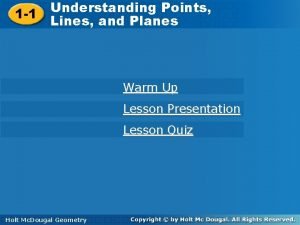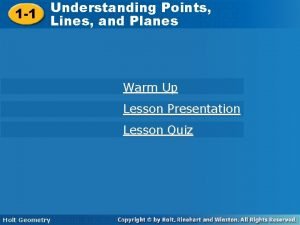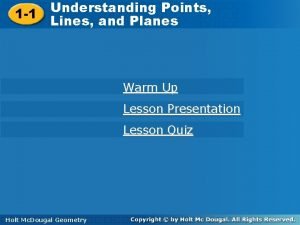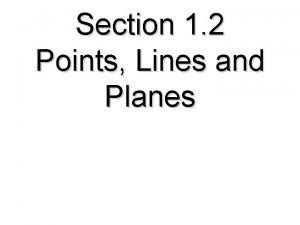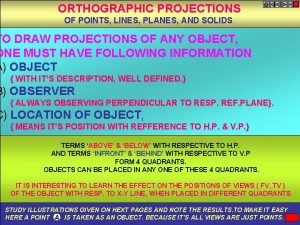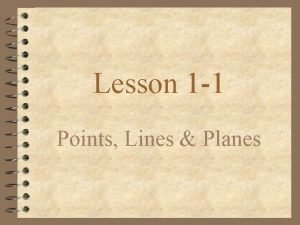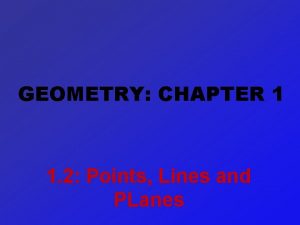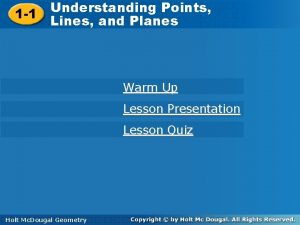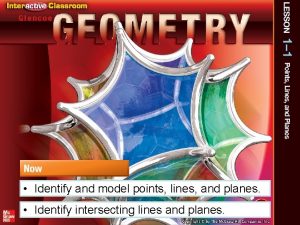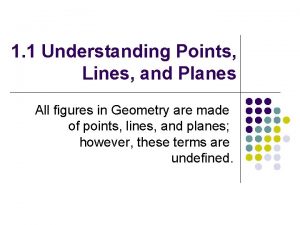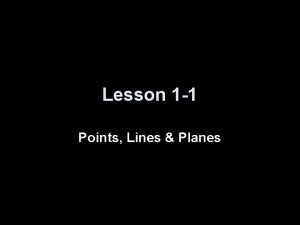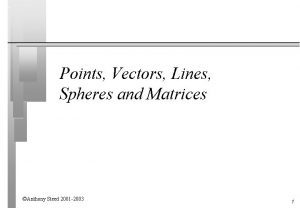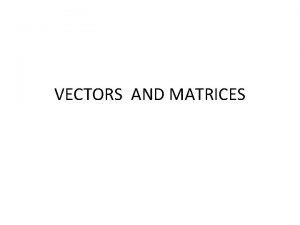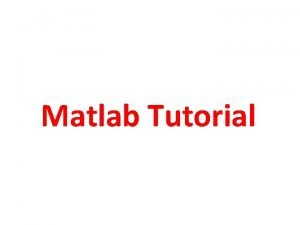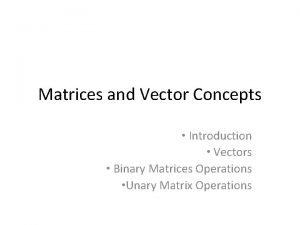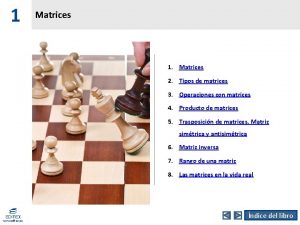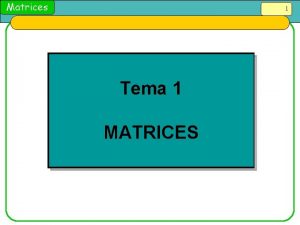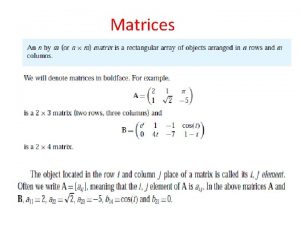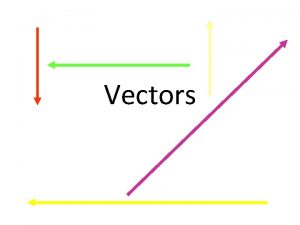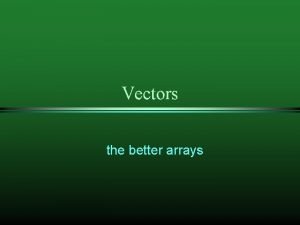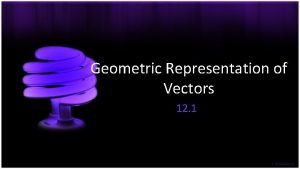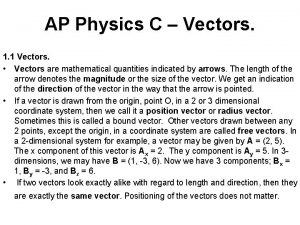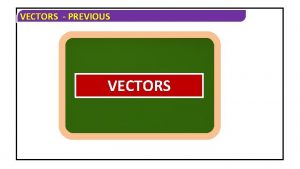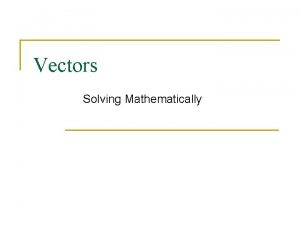Points Vectors Lines Spheres and Matrices Overview Points

































- Slides: 33

Points, Vectors, Lines, Spheres and Matrices

Overview – Points – Vectors – Lines – Spheres – Matrices – 3 D transformations as matrices – Homogenous co-ordinates

Basic Maths • In computer graphics we need mathematics both for describing our scenes and also for performing operations on them, such as projection and various transformations. • Coordinate systems (right- and left-handed), serve as a reference point. • 3 axes labelled x, y, z at right angles.

Co-ordinate Systems Y Y X X Z Right-Handed System (Z comes out of the screen) Z Left-Handed System (Z goes in to the screen)

Points, P (x, y, z) • Gives us a position in relation to the origin of our coordinate system

Vectors, V (x, y, z) • Represent a direction (and magnitude) in 3 D space • Points != Vectors Vector +Vector = Vector Point – Point = Vector Point + Vector = Point + Point = ?

Vectors, V (x, y, z) v w 2 v v (1/2)V (-1)v Vector addition sum v + w Scalar multiplication of vectors (they remain parallel) y w v v+w v P v-w -w Vector difference v - w = v + (-w) O Vector OP x

Vectors V • Length (modulus) of a vector V (x, y, z) |V| = x 2 + y 2 + z 2 • A unit vector: a vector can be normalised such that it retains its direction, but is scaled to have unit length: ^ V = vector V V = modulus of V |

Dot Product u · v = xu ·xv + yu ·yv + zu ·zv u · v = |u| |v| cos = u · v/ |u| |v| • This is purely a scalar number not a vector. • What happens when the vectors are unit • What does it mean if dot product == 0 or == 1?

Cross Product • The result is not a scalar but a vector which is normal to the plane of the other 2 • Can be computed using the determinant of: i xv j yv k zv xu yu zu u x v = i(yvzu -zvyu), -j(xvzu - zvxu), k(xvyu - yvxu) • Size is |u x v| = |u||v|sin • Cross product of vector with itself is null

Parametric equation of a line (ray) Given two points P 0 = (x 0, y 0, z 0) and P 1 = (x 1, y 1, z 1) the line passing through them can be expressed as: P(t) = P 0 + t(P 1 - P 0) With - < t < = x(t) = x 0 + t(x 1 - x 0) y(t) = y 0 + t(y 1 - y 0) z(t) = z 0 + t(z 1 - z 0)

Equation of a sphere • Pythagoras Theorem: a 2 + b 2 = c 2 • Given a circle through the origin with radius r, then for any point P on it we have: b a P r (0, 0) x 2 + y 2 = r 2 hypotenuse c xp yp

Equation of a sphere * If the circle is not centred on the origin: yp r b yc We still have P (xp, yp) a 2 + b 2 = r 2 (xc, yc) a b but a = xp- xc b = yp- yc (0, 0) xc xp a So for the general case (x- xc)2 + (y- yc)2 = r 2

Equation of a sphere * Pythagoras theorem generalises to 3 D giving a 2 + b 2 + c 2 = d 2 Based on that we can easily prove that the general equation of a sphere is: (x- xc)2 + (y- yc)2 + (z- zc)2 = r 2 and at origin: x 2 + y 2 + z 2 = r 2

Matrix Math ©Anthony Steed 2001

Vectors and Matrices • Matrix is an array of numbers with dimensions M (rows) by N (columns) – 3 by 6 matrix – element 2, 3 is (3) • Vector can be considered a 1 x M matrix –

Types of Matrix • Identity matrices - I • Diagonal • Symmetric – Diagonal matrices are (of course) symmetric – Identity matrices are (of course) diagonal

Operation on Matrices • Addition – Done elementwise • Transpose – “Flip” (M by N becomes N by M)

Operations on Matrices • Multiplication – Only possible to multiply of dimensions • m 1 by n 1 and m 2 by n 2 iff n 1 = m 2 – resulting matrix is m 1 by n 2 • e. g. Matrix A is 2 by 3 and Matrix by 3 by 4 – resulting matrix is 2 by 4 • Just because A x B is possible doesn’t mean possible! B x A is

Matrix Multiplication Order • A is m by k , B is k by n • C = A x B defined by • Bx. A not necessarily equal to Ax. B

Example Multiplications

Inverse • If A x B = I and B x A = I then A = B-1 and B = A-1

3 D Transforms • In 3 -space vectors are transformed by 3 matrices

Scale • Scale uses a diagonal matrix • Scale by 2 along x and -2 along z

Rotation • Rotation about z axis Y æ cos ç sin ç è 0 sin cos 0 0ö ÷ 0÷ 1ø (x. cos - y. sin , x. sin + y. cos X • Note z values remain the same whilst x and y change )

Rotation X, Y and Scale • About X æ 1 0 ç ç 0 cos ç 0 - sin è ö ÷ sin ÷ cos ÷ø 0 • About Y æ cos ç ç 0 è sin 0 - sin 1 0 0 cos ö ÷ ÷ ø • Scale (should look familiar)

Homogenous Points • Add 1 D, but constrain that to be equal to 1 (x, y, z, 1) • Homogeneity means that any point in 3 -space can be represented by an infinite variety of homogenous 4 D points – (2 3 4 1) = (4 6 8 2) = (3 4. 5 6 1. 5) • Why? – 4 D allows us to include 3 D translation in matrix form

Homogenous Vectors • • • Vectors != Points Remember points can not be added If A and B are points A-B is a vector Vectors have form (x y z 1) Addition makes sense

Translation in Homogenous Form • Note that the homogenous component is preserved (* * * 1), and aside from the translation the matrix is I

Putting it Together • R is rotation and scale components • T is translation component

Order Matters • Composition order of transforms matters – Remember that basic vectors change so “direction” of translations changed

Exercises • Calculate the following matrix: /2 about X then /2 about Y then /2 about Z (remember “then” means multiply on the right). What is a simpler form of this matrix? • Compose the following matrix: translate 2 along X, rotate /2 about Y, translate -2 along X. Draw a figure with a few points (you will only need 2 D) and then its translation under this transformation.

Matrix Summary • Rotation, Scale, Translation • Composition of transforms • The homogenous form
 Simulink matrix multiplication
Simulink matrix multiplication A plane contains at least _____ point/s
A plane contains at least _____ point/s Brand positioning bullseye example
Brand positioning bullseye example Point of difference and point of parity
Point of difference and point of parity Point a lies in plane p illustration
Point a lies in plane p illustration Bresenham line drawing algorithm equation
Bresenham line drawing algorithm equation Lesson 1-1 basic geometric figures
Lesson 1-1 basic geometric figures 1-1 points lines and planes
1-1 points lines and planes Computer graphics chapter 1 ppt
Computer graphics chapter 1 ppt 1-1 understanding points lines and planes
1-1 understanding points lines and planes Example of opposite rays
Example of opposite rays Understanding points lines and planes
Understanding points lines and planes Quiz 1-2 distance and midpoint
Quiz 1-2 distance and midpoint Worksheet 1-1 points lines and planes day 1
Worksheet 1-1 points lines and planes day 1 Worksheet 1-1 points lines and planes day 1
Worksheet 1-1 points lines and planes day 1 Points, lines, and planes worksheet answers unit 1 lesson 1
Points, lines, and planes worksheet answers unit 1 lesson 1 2d geometric transformation in computer graphics ppt
2d geometric transformation in computer graphics ppt How many planes appear in the figure
How many planes appear in the figure 1-2 points lines and planes answer key geometry
1-2 points lines and planes answer key geometry 1-1 understanding points lines and planes answer key
1-1 understanding points lines and planes answer key Lesson 1-1 understanding points lines and planes
Lesson 1-1 understanding points lines and planes Reteach understanding points, lines, and planes answer key
Reteach understanding points, lines, and planes answer key Lesson 1-1 understanding points lines and planes
Lesson 1-1 understanding points lines and planes Points lines and planes vocabulary worksheet
Points lines and planes vocabulary worksheet Projection of points in different quadrants
Projection of points in different quadrants The top view of a 75mm long line ab measures 65mm
The top view of a 75mm long line ab measures 65mm Lesson 1-1 points lines and planes
Lesson 1-1 points lines and planes Geometry 1-2 points lines and planes
Geometry 1-2 points lines and planes Collinear points in real life
Collinear points in real life Practice a understanding points lines and planes
Practice a understanding points lines and planes Draw and label a figure for each relationship
Draw and label a figure for each relationship How many planes appear in the figure?
How many planes appear in the figure? Understanding points lines and planes
Understanding points lines and planes How many planes appear in the figure?
How many planes appear in the figure?
